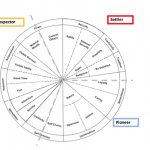If It Works For Greenpeace, why not copy them
A year ago I met a senior Greenpeace staffer and a victory reception for the Common Fisheries Policy and I asked them what Greenpeace did that made so many of their campaigns win?
The staffer explained two things to me that amounted to using (1) Value Communications and (2) Social Network Analysis (which I may write about later on).
I came across a good piece where Karen Rothwell of Greenpeace develops that thinking. She writes:
“Value Modes provide a powerful additional tool for developing almost any form of communication because they give insights into the emotional motivations when, and how these differ across different groups. The holy grail communicators is to be able to see and feel the world is the people that want to root see and feel, and value modes can help us do that. Without this insight it’s all too easy to develop work based on what works me – and come up with things that don’t work from the people we want to reach.
Why I Use It
I use Value Communications for a very simple reason. It works.
I use it with some of my clients. I explained the ideas before hand behind the thinking before hand, and if clients are comfortable with it, we can use it.
I been reading Chris Roses books since I was an undergraduate. That is a long long time ago. A few years ago I met Chris Rose and we have kept in touch. When we met, he mentioned his latest book ‘What makes people tick’, I bought it and I read all 238 pages in a few days. I been posting copies to friends and contacts ever since!
How to guess what the other side want
A client asked me how I seem to be able to anticipate what the other side are going to do and say. It’s not hard I explained. I just tried to look at things as they do. When you can do that, it’s very easy to guess what the other side are going to say, the arguments they will use, and how they will react, or not, to the points you raise.
It Worked for Reagan, Clinton and Blair
I came across what I now call Value Communications through excellent documentary by Adam Curtis about the life of Edward Bernays. The “history of self”, which you can watch here, explains in its final episodes about how politicians starting with Ronald Reagan, then used by Bill Clinton and imported to Europe by Tony Blair, had used psychological insights into how people think and what makes them tick to reach out to them and speak directly with them on.
If the leading campaigners and politicians of our day can use these techniques surely there is a lot worthwhile using them.
Health Warning
There is an important warning. If you want to persuade people to your way of thinking and on your terms, so that they look at the world exactly as you see it, please read no further. It does not work!
Settlers, Pioneers and Prospectors
Chris Rose and his colleagues at Cultural Dynamics Strategy and Marketing help map the values of settlers, prospectors, pioneers. Please see the diagram below. They have done it for many European countries.
When you read it, it’s really very obvious and intuitive that different groups of people look at the same thing in very different ways. To be honest it’s so bloody obvious that it is bewildering that most campaigns, whether by NGOs or firms, basically come down to “see the world as I do and support us, and if you don’t you should”.
This strategy amounts to little more than wishful thinking. It’s predicated on the hope that the people you are trying to persuade, whether they are 500 politicians and regulators, several thousand people see the world as you do.
I realised a long time ago that there are very few people in the world who share the same values and perspectives that I do. I learnt that trying to persuade 99% of any given audience that they are wrong and I am right is, in most cases, not going to work out for me.

How I Use Value Communications
I have used value communications with two progressive clients. One working in the fisheries agenda and another in the energy field.
It’s really very easy. First, you look at the group of men and women you are trying to persuade. You look at, or guess, what value group they come from: are they settlers, pioneers, or prospectors.
You then take your various positions and deconstruct them, and turn them into the language that each of the groups would use.
It’s also very helpful to develop plain and simple stories and examples to support your position. A plain and easy to read graph works wonders.
Dangerous Side Effects
The side-effects are remarkable. For a fisheries client it led to politicians from across the political spectrum embracing the client’s position as if it were their own.
For the other client I later found out that it had helped change the mind of an influential official who recommend their politician change their position on a key vote. As someone reported back “it was like you knew the concerns of X and you cleared their concerns away in the language that X understood. No one does that in Brussels”.